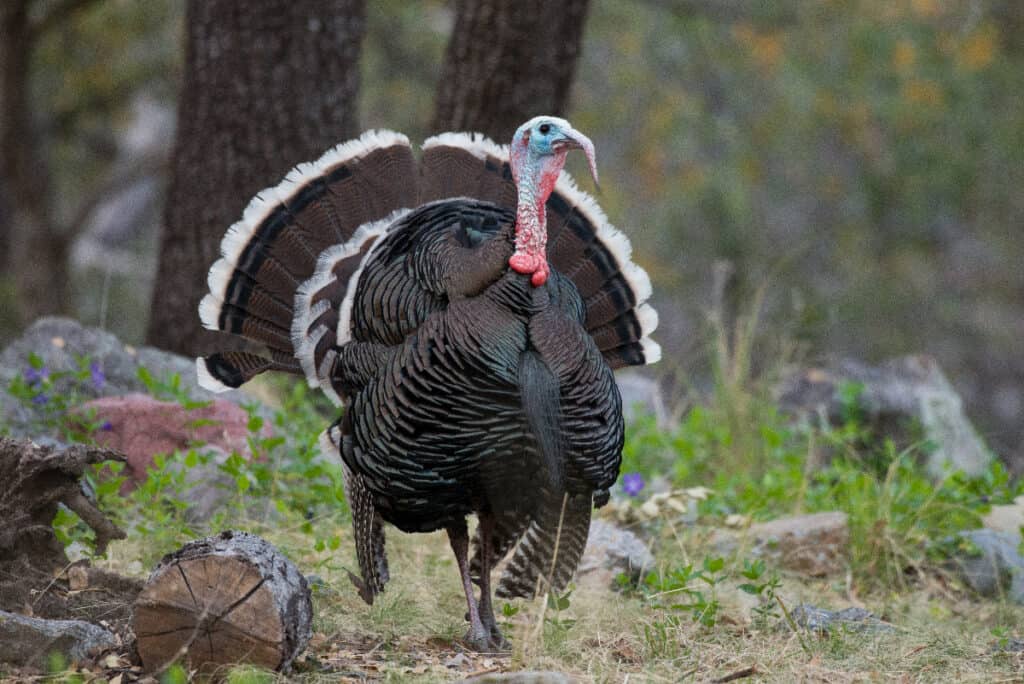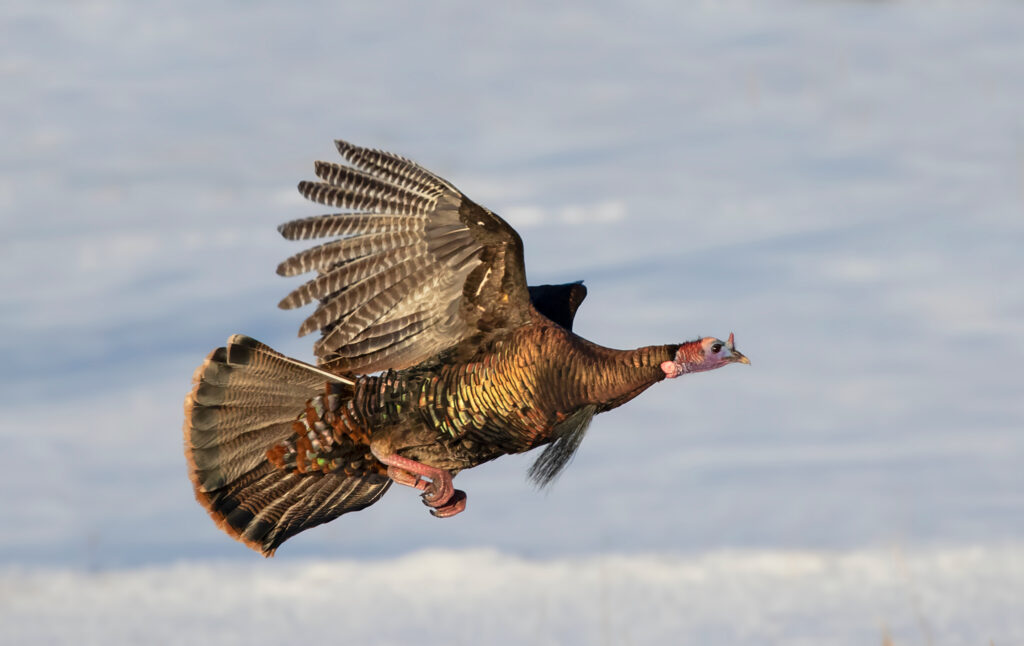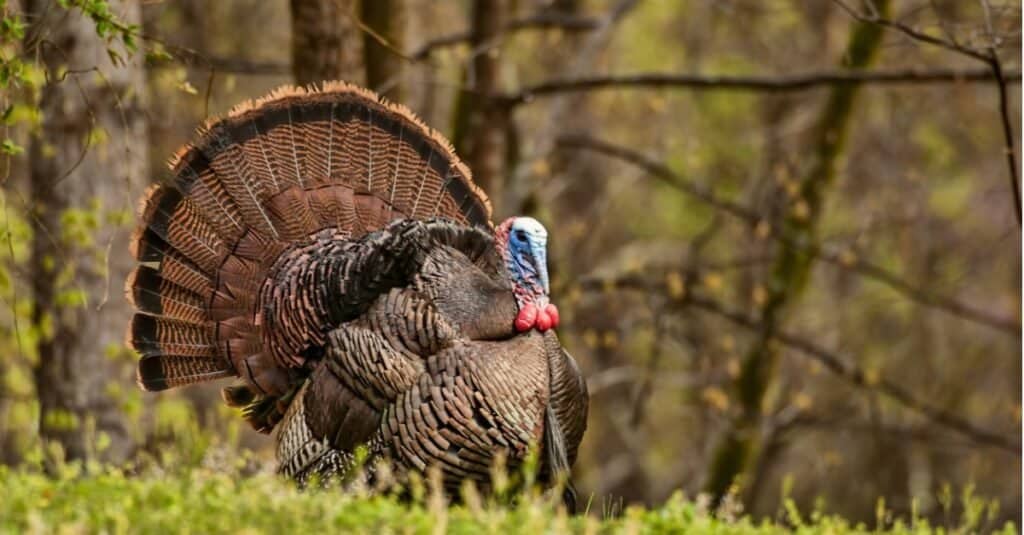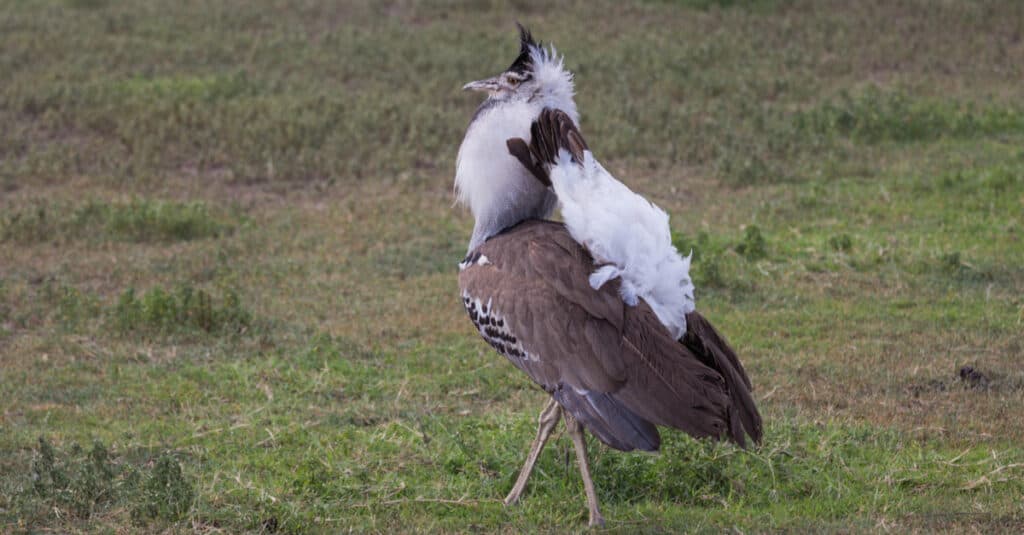Turkeys are ground birds that originated in Central and North America. Most people probably know them as the central meal during the Thanksgiving holiday in the United States. Given that millions of them are served throughout the country every year, people probably want to know, can turkeys fly? Looking at their size, you may have some doubts about whether this creature can get airborne.
Take a look and see whether these animals can fly and why the subject comes up so frequently.
Are All Turkeys Alike?

Wild turkeys and domestic turkeys belong to the same species
©Sean R. Stubben/Shutterstock.com
The common perception of a turkey is a large fowl with broad, fan-shaped tail plumage and a wattle. It’s no wonder people wonder whether turkeys can fly since their bodies don’t look very aerodynamic, even wild ones. Not all turkeys are alike, though.
Generally speaking, two types of turkeys are found in North America. They are the wild turkey (Meleagris gallopavo) and the domestic turkey (Meleagris gallopavo domesticus). These two creatures come from the same genus and species, but the domestic turkeys are subspecies bred so that humans can eat them. A second species of turkey also lives in Mexico, but we’re not going to focus on them.
Due to the intensive farming of turkeys in the U.S. and other countries around the world, the domestic turkey has diverged from the wild turkey in several notable ways.
In the pursuit of getting the most meat per animal, domestic turkeys are much larger and heavier than their wild counterparts. The average male wild turkey weighs between 11 and 24 pounds while growing about 3.1 to 4 feet in length. The average male domestic turkey weighs between 29 and 39 pounds while growing 3.3 to 4.1 feet in total length.
Both birds are very large, and they’re frequently seen on the ground. Does that mean that they can’t fly? Given their size, it’s hard to imagine them taking to the air.
Can Wild Turkeys Fly?

Wild turkeys can fly short distances of up to a quarter-mile.
©Jim Cumming/Shutterstock.com
Wild turkeys can fly even though they spend the majority of their time on the ground. They feed while they’re on the ground. Not only can they fly, but they can fly at high speeds between 40 and 55 mph depending on the source.
However, wild turkeys only fly for relatively short distances of about a quarter mile. They don’t need to fly great distances because they don’t migrate for winter like geese. These birds still prefer to spend the majority of their time on the ground, though. After all, that is where turkeys find their preferred foods like grains, seeds, vegetables, insects, and more.
The wild turkey’s ability to fly is imperative to its survival. If they were not capable of flying for the short distances they reach, predators would have a much easier time killing them.
Knowing that wild turkeys are capable of flying, it’s time to consider the domestic turkey.
Do Domestic Turkeys Fly?

Young domestic turkeys can fly, but they lose the ability to fly as they grow into adulthood.
©iStock.com/Jens_Lambert_Photography
Young domestic turkeys can fly, but they lose the ability to fly as they grow into adulthood. The young chicks, called poults, can start flying short distances 8 to 14 days after they hatch. However, as the turkeys start to get older, they begin to gain a lot of mass in their breasts.
It’s tempting to think that larger breast muscles could actually lead to better flight. That is not the case, though. Instead, the domestic turkey starts to lose out on the power-to-mass ratio. By the time they’re adults, domestic turkeys cannot flap their wings fast enough to take flight.
So, adult domestic turkeys are stuck on the ground. However, they do not have to worry about wild predators for the most part. The vast majority of domestic turkeys are contained on farms where they are raised for food. Flying doesn’t really benefit them the same way it does wild turkeys, so it’s not much of a loss.
What’s the Heaviest Flying Bird Alive Today?

The Kori bustard is one of the largest flying birds alive today.
©TheLearningPhotographer/Shutterstock.com
The Kori bustard and the great bustard are among the two heaviest flying birds alive today. They can reach weights of 46 pounds and can take flight. Thus, their weight alone is not what keeps turkeys from flying. After all, birds that are about the same mass as turkeys regularly take to the skies.
The domestic turkey’s enormous muscles prevent it from flapping enough to take flight. Still, other heavy birds with much longer wingspans can also fly. The largest extant bird in North America is the trumpeter swan. This massive bird measures about 4.6 to 5.5 feet long, weighs about 30 pounds, and can have a wingspan of about 6 feet to 8.2 feet with a maximum of just over 10 feet!
These enormous birds can easily fly long distances, and they even migrate to wintering grounds when the weather turns too cold. So, very large birds can and do take flight. So, it should not be surprising that wild turkeys can fly reasonably well despite their size and weight, even though it’s for short distances.
Interesting Turkey Facts

Turkeys are the highlight of the Thanksgiving dinner in millions of households in North America.
©iStock.com/pondsaksit
Now that we have answered the question, Can turkeys fly? we can move on to other interesting facts about turkeys. Take a look at some other interesting facets of these birds’ lives.
- Wild turkeys can spend the night in trees.
- Wild turkeys came close to extinction in the 1900s after they were hunted down to a population of 30,000.
- Turkeys can run over 20 mph when trying to get away from danger.
- Although Ben Franklin was fascinated by turkeys, he never publicly tried to make them the national symbol of the United States.
- Six different subspecies of wild turkeys are found in North America, and another member of the Meleagris genus, the ocellated turkey, can be found in Mexico’s Yucatan Peninsula.
These are just a few other interesting facts about turkeys, but many others exist. They’re a fascinating bird with a history tied to that of the people who lived in North America long ago. These days, turkeys mostly step into the spotlight during the holiday season. Still, it’s interesting to know that turkeys can fly, especially the wild ones that live across the continent.
Thank you for reading! Have some feedback for us? Contact the AZ Animals editorial team.








